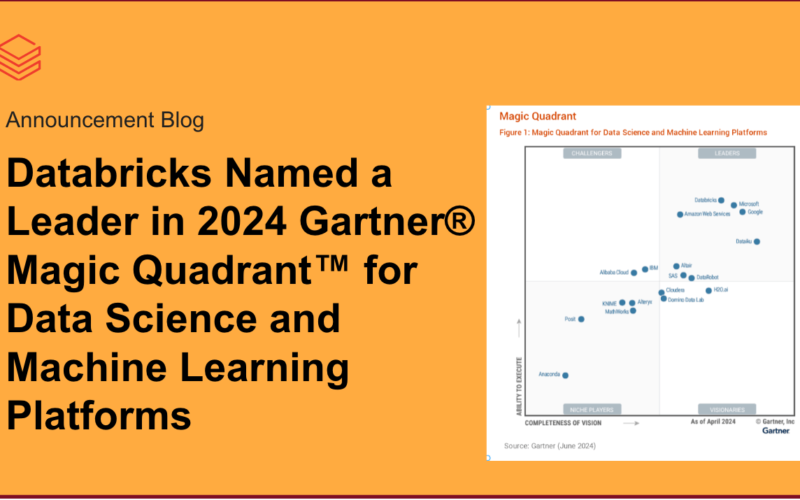We are excited to announce that Gartner has recognized Databricks as a Leader in the 2024 Gartner® Magic Quadrant™ for Data Science and Machine Learning Platforms. A leader provides a mature offering that meets market demand and has demonstrated the vision necessary to sustain their market position as requirements evolve. Gartner defines a data science and machine learning platform as an integrated set of libraries and tooling that support data scientists collaborating with their business and IT counterparts through all stages of the life cycle. These stages include business understanding, data access and preparation, experimentation and model creation, and sharing of insights. In addition to being named a Leader, we are thrilled to be recognized as the highest vendor in the Ability to Execute
Download a complimentary copy of the report here.
Figure 1: Magic Quadrant for Data Science and Machine Learning Platforms
A key change that occurred between the 2021 and 2024 magic quadrants is the inclusion of Generative AI. This considers the capabilities to use, fine-tune, and build custom large language models as part of the overall data science and machine learning platform. We believe one of the reasons that contributed to our placement in the Gartner Magic Quadrant is Databricks’ should be focus on both GenAI and on traditional data science and machine learning
At Databricks, customer obsession and innovation continues to fuel our product roadmap. We’ve been rapidly expanding our Data Intelligence Platform to truly democratize Data + AI. Databricks Mosaic AI provides unified tooling to build, deploy and monitor AI and ML solutions — from building predictive models to the latest GenAI and large language models (LLMs). Built on the Databricks Data Intelligence Platform, Mosaic AI enables organizations to securely and cost-effectively integrate their enterprise data into the AI lifecycle
- Complete ownership over your models and data: You can securely build and customize your own machine learning and generative AI models, powering them with a semantic understanding of your business without sending your data and IP outside your walls.
- Production-quality: Mosaic AI helps customers deploy production-quality GenAI applications that are safe, accurate, and governed. It has built-in access controls, and governance capabilities ensuring no user will be able to access data they do not have the rights to. There are built-in guardrails to identify unsafe content and prevent responses to such requests. All output is carefully monitored, including for toxic and unsafe content as well as to diagnose errors. With native governance powered by Unity Catalog, you can govern and track lineage across all data and AI assets.
- Cost: With Mosaic AI, you can both serve open models or build your own custom large language model from scratch more cost-effectively. Instead of using proprietary models that charge a premium, open LLMs deployed using Mosaic AI Model Serving can be deployed up to 5x more cost effectively. Or for organizations that want to build their own large language model that is fully tailored to their specific domain, Mosaic AI Foundation Model Training can help them build new multibillion parameter LLMs in days with up to 10x lower training costs.
What’s next
We believe our recognition as a Leader with the highest scores for Ability to Execute is a testament to Databricks’ success and our ability to bring together data teams and enable them to create the next generation of data and AI applications with quality, speed, and agility. In combination with our positioning as a Leader in the Gartner Cloud Database Management Systems MQ, Databricks is now the only cloud-native vendor to be recognized as a Leader in both Magic Quadrant reports. We consider our positioning as a Leader in both of these reports to be a defining moment for the Databricks Data Intelligence Platform and confirmation of our vision to democratize data and AI.
We believe the uniqueness of the achievement is in how it was accomplished. It is not uncommon for vendors to show up in multiple Magic Quadrants each year across many domains. But, they are assessed on disparate products in their portfolio that individually accomplish the specific criteria of the report. Databricks’ results show definitively that you can be a leader with a unified approach to Data + AI, with one copy of data, one processing engine, one approach to management and governance that’s built on open source and open standards across all clouds. You can deliver class-leading outcomes for both data warehousing and data science/machine learning workloads with a single solution. We believe that ML and GenAI will continue to transform data platforms and we thank our customers and partners for being on this journey with us.
Learn more
To learn more about Mosaic AI, visit our website and follow @Databricks for the latest news and updates. You can also view session replays from the Data + AI Summit 2024.
Read the Gartner Magic Quadrant for Data Science and Machine Learning Platforms.
Gartner, Magic Quadrant for Data Science and Machine Learning Platforms, Afraz Jaffri, Aura Popa, Peter Krensky, Jim Hare, Raghvender Bhati, Maryam Hassanlou, Tong Zhang, 17 June 2024
GARTNER is a registered trademark and service mark of Gartner, Inc. and/or its affiliates in the U.S. and internationally, and MAGIC QUADRANT is a registered trademark of Gartner, Inc. and/or its affiliates and are used herein with permission. All rights reserved.
Gartner does not endorse any vendor, product or service depicted in its research publications, and does not advise technology users to select only those vendors with the highest ratings or other designation. Gartner research publications consist of the opinions of Gartner’s research organization and should not be construed as statements of fact. Gartner disclaims all warranties, expressed or implied, with respect to this research, including any warranties of merchantability or fitness for a particular purpose.
This graphic was published by Gartner, Inc. as part of a larger research document and should be evaluated in the context of the entire document. The Gartner document is available upon request from Databricks.
Source link
lol

